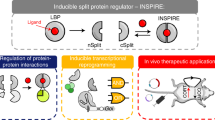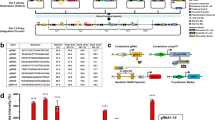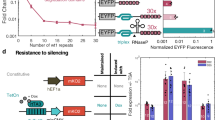Abstract
Chemically inducible gene switches that regulate expression of endogenous genes have multiple applications for basic gene expression research and gene therapy. Single-chain zinc-finger transcription factors that utilize either estrogen receptor homodimers or retinoid X receptor-α/ecdysone receptor heterodimers are shown here to be effective regulators of ICAM-1 and ErbB-2 transcription. Using activator (VP64) and repressor (Krüppel-associated box) domains to impart regulatory directionality, ICAM-1 was activated by 4.8-fold and repressed by 81% with the estrogen receptor-inducible transcription factors. ErbB-2 was activated by up to threefold and repressed by 84% with the retinoid X receptor-α/ecdysone receptor-inducible transcription factors. The dynamic range of these proteins was similar to the constitutive system and showed negligible basal regulation when ligand was not present. We have also demonstrated that the regulation imposed by these inducible transcription factors is dose dependent, sustainable for at least 11 days and reversible upon cessation of drug treatment. Importantly, these proteins can be used in conjunction with each other with no detectable overlap of activity enabling concurrent and temporal regulation of multiple genes within the same cell. Thus, these chemically inducible transcription factors are valuable tools for spatiotemporal control of gene expression that should prove valuable for research and gene therapy applications.
This is a preview of subscription content, access via your institution
Access options
Subscribe to this journal
Receive 12 print issues and online access
$259.00 per year
only $21.58 per issue
Buy this article
- Purchase on Springer Link
- Instant access to full article PDF
Prices may be subject to local taxes which are calculated during checkout






Similar content being viewed by others
References
Beerli RR, Barbas III CF . Engineering polydactyl zinc-finger transcription factors. Nat Biotechnol 2002; 20: 135–141.
Jamieson AC, Miller JC, Pabo CO . Drug discovery with engineered zinc-finger proteins. Nat Rev Drug Discov 2003; 2: 361–368.
Segal DJ, Dreier B, Beerli RR, Barbas III CF . Toward controlling gene expression at will: selection and design of zinc finger domains recognizing each of the 5′-GNN-3′ DNA target sequences. Proc Natl Acad Sci USA 1999; 96: 2758–2763.
Dreier B, Segal DJ, Barbas III CF . Insights into the molecular recognition of the 5′-GNN-3′ family of DNA sequences by zinc finger domains. J Mol Biol 2000; 303: 489–502.
Dreier B, Beerli RR, Segal DJ, Flippin JD, Barbas III CF . Development of zinc finger domains for recognition of the 5′-ANN-3′ family of DNA sequences and their use in the construction of artificial transcription factors. J Biol Chem 2001; 276: 29466–29478.
Liu Q, Xia Z, Zhong X, Case CC . Validated zinc finger protein designs for all 16 GNN DNA triplet targets. J Biol Chem 2002; 277: 3850–3856.
Dreier B, Fuller RP, Segal DJ, Lund CV, Blancafort P, Huber A et al. Development of zinc finger domains for recognition of the 5′-CNN-3′ family DNA sequences and their use in the construction of artificial transcription factors. J Biol Chem 2005; 280: 35588–35597.
Liu Q, Segal DJ, Ghiara JB, Barbas III CF . Design of polydactyl zinc-finger proteins for unique addressing within complex genomes. Proc Natl Acad Sci USA 1997; 94: 5525–5530.
Margolin JF, Friedman JR, Meyer WK, Vissing H, Thiesen HJ, Rauscher III FJ . Kruppel-associated boxes are potent transcriptional repression domains. Proc Natl Acad Sci USA 1994; 91: 4509–4513.
Ayer DE, Laherty CD, Lawrence QA, Armstrong AP, Eisenman RN . Mad proteins contain a dominant transcription repression domain. Mol Cell Biol 1996; 16: 5772–5781.
Beerli RR, Segal DJ, Dreier B, Barbas III CF . Toward controlling gene expression at will: specific regulation of the erbB-2/HER-2 promoter by using polydactyl zinc finger proteins constructed from modular building blocks. Proc Natl Acad Sci USA 1998; 95: 14628–14633.
Beerli RR, Schopfer U, Dreier B, Barbas CFI . Chemically regulated zinc finger transcription factors. J Biol Chem 2000; 275: 32617–32627.
Blancafort P, Magnenat L, Barbas CF . Scanning the human genome with combinatorial transcription factor libraries. Nat Biotechnol 2003; 21: 269–274.
Park KS, Lee DK, Lee H, Lee Y, Jang YS, Kim YH et al. Phenotypic alteration of eukaryotic cells using randomized libraries of artificial transcription factors. Nat Biotechnol 2003; 21: 1208–1214.
Magnenat L, Blancafort P, Barbas III CF . In vivo selection of combinatorial libraries and designed affinity maturation of polydactyl zinc finger transcription factors for ICAM-1 provides new insights into gene regulation. J Mol Biol 2004; 341: 635–649.
Bartsevich VV, Juliano RL . Regulation of the MDR1 gene by transcriptional repressors selected using peptide combinatorial libraries. Mol Pharmacol 2000; 58: 1–10.
Corbi N, Libri V, Fanciulli M, Tinsley JM, Davies KE, Passananti C . The artificial zinc finger coding gene ‘Jazz’ binds the utrophin promoter and activates transcription. Gene Therapy 2000; 7: 1076–1083.
Beerli RR, Dreier B, Barbas III CF . Positive and negative regulation of endogenous genes by designed transcription factors. Proc Natl Acad Sci USA 2000; 97: 1495–1500.
Zhang L, Spratt SK, Liu Q, Johnstone B, Qi H, Raschke EE et al. Synthetic zinc finger transcription factor action at an endogenous chromosomal site. Activation of the human erythropoietin gene. J Biol Chem 2000; 275: 33850–33860.
Liu PQ, Rebar EJ, Zhang L, Liu Q, Jamieson AC, Liang Y et al. Regulation of an endogenous locus using a panel of designed zinc finger proteins targeted to accessible chromatin regions. Activation of vascular endothelial growth factor A. J Biol Chem 2001; 276: 11323–11334.
Ren D, Collingwood TN, Rebar EJ, Wolffe AP, Camp HS . PPARgamma knockdown by engineered transcription factors: exogenous PPARgamma2 but not PPARgamma1 reactivates adipogenesis. Genes Dev 2002; 16: 27–32.
Rebar EJ, Huang Y, Hickey R, Nath AK, Meoli D, Nath S et al. Induction of angiogenesis in a mouse model using engineered transcription factors. Nat Med 2002; 8: 1427–1432.
Toniatti C, Bujard H, Cortese R, Ciliberto G . Gene therapy progress and prospects: transcription regulatory systems. Gene Therapy 2004; 11: 649–657.
Xu D, Ye D, Fisher M, Juliano RL . Selective inhibition of P-glycoprotein expression in multidrug-resistant tumor cells by a designed transcriptional regulator. J Pharmacol Exp Ther 2002; 302: 963–971.
Kang JS, Kim JS . Zinc finger proteins as designer transcription factors. J Biol Chem 2000; 275: 8742–8748.
Pollock R, Giel M, Linher K, Clackson T . Regulation of endogenous gene expression with a small-molecule dimerizer. Nat Biotechnol 2002; 20: 729–733.
Dent CL, Lau G, Drake EA, Yoon A, Case CC, Gregory PD . Regulation of endogenous gene expression using small molecule-controlled engineered zinc-finger protein transcription factors. Gene Therapy 2007; 14: 1362–1369.
Perissi V, Menini N, Cottone E, Capello D, Sacco M, Montaldo F et al. AP-2 transcription factors in the regulation of ERBB2 gene transcription by oestrogen. Oncogene 2000; 19: 280–288.
Chadwick CC, Shaw LJ, Winneker RC . TNF-alpha and 9-cis-retinoic acid synergistically induce ICAM-1 expression: evidence for interaction of retinoid receptors with NF-kappa B. Exp Cell Res 1998; 239: 423–429.
Cilenti L, Toniato E, Ruggiero P, Fusco C, Farina AR, Tiberio A et al. Transcriptional modulation of the human intercellular adhesion molecule gene I (ICAM-1) by retinoic acid in melanoma cells. Exp Cell Res 1995; 218: 263–270.
Janssens S, Bols L, Vandermeeren M, Daneels G, Borgers M, Geysen J . Retinoic acid potentiates TNF-alpha-induced ICAM-1 expression in normal human epidermal keratinocytes. Biochem Biophys Res Commun 1999; 255: 64–69.
Aoudjit F, Bosse M, Stratowa C, Voraberger G, Audette M . Regulation of intercellular adhesion molecule-1 expression by retinoic acid: analysis of the 5′ regulatory region of the gene. Int J Cancer 1994; 58: 543–549.
Liu X, Constantinescu SN, Sun Y, Bogan JS, Hirsch D, Weinberg RA et al. Generation of mammalian cells stably expressing multiple genes at predetermined levels. Anal Biochem 2000; 280: 20–28.
Harwerth I-M, Wels W, Marte BM, Hynes NE . Monoclonal antibodies against the extracellular domain of the erbB-2 receptor function as partial ligand agonists. J Biol Chem 1992; 267: 15160–15167.
Acknowledgements
This study was supported in part by the National Institute of Health Grant GM065059 to CFB. LM was the recipient of postdoctoral fellowships from the Swiss National Science Foundation. LJS is supported by The American Cancer Society Illinois Division—Linda M Campbell Postdoctoral Fellowship.
Author information
Authors and Affiliations
Corresponding author
Rights and permissions
About this article
Cite this article
Magnenat, L., Schwimmer, L. & Barbas, C. Drug-inducible and simultaneous regulation of endogenous genes by single-chain nuclear receptor-based zinc-finger transcription factor gene switches. Gene Ther 15, 1223–1232 (2008). https://doi.org/10.1038/gt.2008.96
Received:
Revised:
Accepted:
Published:
Issue Date:
DOI: https://doi.org/10.1038/gt.2008.96
Keywords
This article is cited by
-
Integrated analysis of transcription factors and targets co-expression profiles reveals reduced correlation between transcription factors and target genes in cancer
Functional & Integrative Genomics (2019)
-
The myeloid-binding peptide adenoviral vector enables multi-organ vascular endothelial gene targeting
Laboratory Investigation (2014)
-
Design and Development of Artificial Zinc Finger Transcription Factors and Zinc Finger Nucleases to the hTERT Locus
Molecular Therapy - Nucleic Acids (2013)
-
A Potential New Therapeutic Approach for Friedreich Ataxia: Induction of Frataxin Expression With TALE Proteins
Molecular Therapy - Nucleic Acids (2013)
-
Benzoate X receptor zinc-finger gene switches for drug-inducible regulation of transcription
Gene Therapy (2012)



